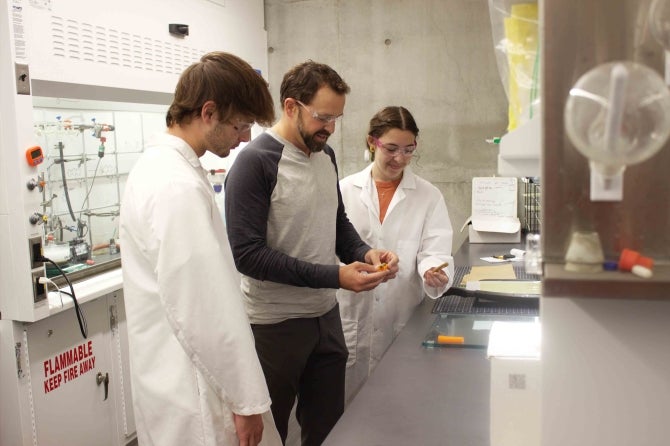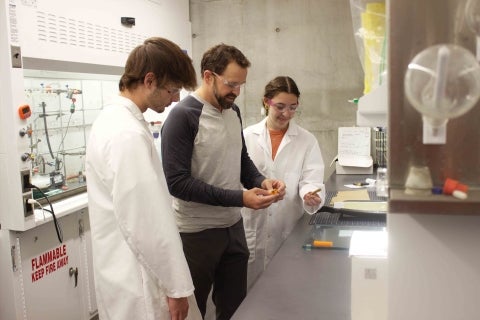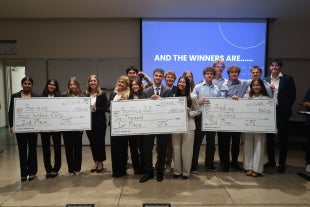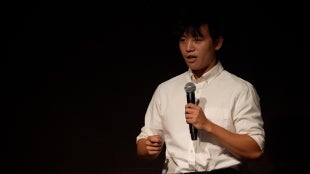Eco-Friendly Glue Breakthrough Designed by Cal Poly Chemistry Team Receives Patent

Contact: Nick Wilson
805-235; nwilso28@calpoly.edu
Public-private partnership between the university and East Coast-based Geisys Venture is also the basis of a joint commercial venture for products that are designed for disassembly
SAN LUIS OBISPO — An innovative, ecofriendly glue designed by a Cal Poly chemistry research team in collaboration with an East Coast company has been approved for a U.S. government patent.
The patent, approved Nov. 21, creates a pathway for proprietary commercial production of the glue innovation under the direction of the Massachusetts-based company Geisys Ventures with involvement of Cal Poly chemistry faculty and students in research and development as part of a memorandum of understanding between the university and Geisys. The new adhesive has potential to reduce landfill waste and positively impact the environment on a broad scale.
The product, to be formally commercialized under the name D-Glue (for “debondable glue”), was created by Cal Poly chemistry Professor Phil Costanzo and Kris Stokes, CEO of Geisys Ventures.

The chemists are continuing research and development of the new adhesive with assistance from a team of Costanzo’s undergraduate students in Cal Poly’s Bailey College of Science and Mathematics.
The aim of the partnership is to launch the new adhesive broadly as a commercial product, offering companies a glue that makes it economically feasible to recycle valuable components that are currently ending up in landfills.
The patent establishes the team's ownership and intellectual property of the technology for use across multiple industries and global market sectors, including apparel, electronics and energy (for use in products such as wind turbines and solar cells). Moreover, the public-private partnership is the basis of a joint commercial venture.
“This step validates our work as a relevant industrial process,” Costanzo said. “Many people are trying to do this in polymer science, and we’ve been one of the early adopters of this idea. The concept of design for disassembly is still relatively new.”
Extreme heat is typically required to separate recyclable materials from the glue currently in use, and often the cost is prohibitive, discouraging reclamation that saves waste and environmental pollution. D-Glue is designed so that it can be broken apart at lower temperatures, requiring much less energy, while maintaining the integrity of the item.
Currently, Geisys Ventures is in talks with multiple prospective corporations and product manufacturers on the use of the glue for commercial and industrial applications.
“We hope our product will help companies to improve their yields and have materials that you can repair by pulling them apart instead of just discarding them as waste,” Stokes said. “Salvaging old materials will be really beneficial to the environment and the circular economy.”
Costanzo and Stokes, who have known each other since they were chemistry undergraduate students at Carnegie Mellon University in Pittsburgh, invented the adhesive over the past few years using a sequence of bonds that link one polymer chain to another, referred to as Diels-Alder linkages, into the product.

Polymers are substances with large molecules and are the basis of many living organisms and manmade materials.
Under supervision from Costanzo and Stokes, Cal Poly students will continue with the research and development of the product as it scales up.
“Being able to do meaningful research as an undergrad is such a huge opportunity and unique to Cal Poly and its Learn by Doing mission,” said Sophia Newcomer, a second-year biochemistry major and Frost Fund program researcher from Sacramento, California. “I really appreciate that Cal Poly has so many chemistry projects that are focused on sustainability, like this one is.”
Ryan Donnelly, a second-year chemistry major from Redwood City, California, said the practice experience of the lab process has been invaluable.
“It's almost like what you would expect in an industry job,” said Donnelly, also a Frost researcher. “We’ve been able to build a product from the ground up and take it from the theoretical stage through the experimental to an actual, marketable product. We see what customers want and specialize our experiments to their specific needs.”
To review the website link to the U.S. government patent, go to the following: https://image-ppubs.uspto.gov/dirsearch-public/print/downloadPdf/11820926.
About Bailey College of Science of Mathematics
Cal Poly’s Bailey College of Science and Mathematics, home to about 2,800 undergraduate and roughly 280 graduate students, offers degrees in biology, chemistry, kinesiology and public health, physics, mathematics, statistics, marine science, microbiology, and biochemistry. The college also houses the university’s undergraduate Liberal Studies program for future teachers, and Cal Poly’s post-baccalaureate School of Education. Bailey College embraces Cal Poly’s Learn by Doing mission, is an esteemed institution, noted for outstanding undergraduate research and significant student co-authorship participation on scientific journal publications.


